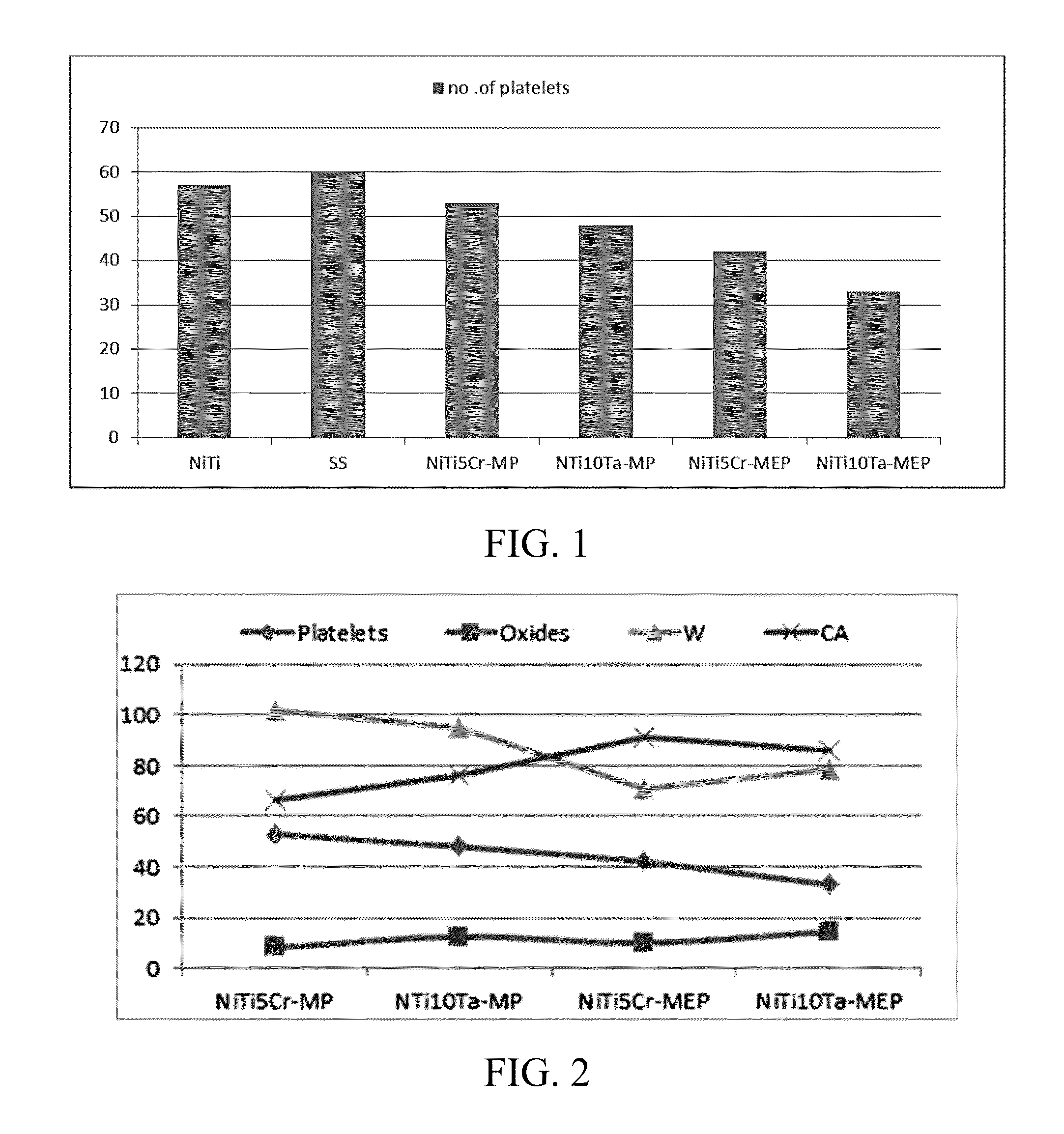Novel nitinol alloys and uses thereof in surgical implants
a technology of surgical implants and nitinol alloys, which is applied in the field of new nitinol alloys and surgical implants, can solve the problems of major bleeding complications, cardiac implants such as stents and vascular access devices, and associated with a number of significant deleterious health events, so as to reduce the risk of clotting, eliminate flushing, and minimize infection and damage to blood vessels
- Summary
- Abstract
- Description
- Claims
- Application Information
AI Technical Summary
Benefits of technology
Problems solved by technology
Method used
Image
Examples
example 1
MEP Decreases Platelet Adhesion on Ternary Nitinol Alloys
[0055]The amount of platelets adhered on MEP NiTi10Ta (33 cells / mm2) and MEP NiTi5Cr (42 cells / mm2) was lower as compared with that on mechanically polished NiTi10Ta (48 cells / mm2) and MP NiTi5Cr (53 cells / mm2). In order to establish whether the magnitude of platelet adhesion per unit surface for each alloy was significantly different, Tukey's HSD (honestly significant difference) test was conducted. It revealed that platelet adhesion on MEP nitinol alloys was significantly different (p<0.05) from that on untreated nitinol alloys.
[0056]FIG. 2 shows platelet adhesion on MP and MEP treated nitinol alloys with respect to surface chemistry (oxide), work of adhesion (W), and contact angle (CA). The lowest concentration of platelet adhesion was observed on MEP NiTi10Ta. This can be the result of a) structure of the oxide layer, b) chemistry of the oxide and / or c) the amount of oxide which influences the hemocompatibility.
[0057]Plate...
example 2
MEP Treatment Produces Specific Titanium Oxides on Ternary Nitinol Surface
[0059]Rutile is the common titanium oxide formed on binary nitinol. The crystal structure of titanium oxide on MEP NiTi10Ta was anatase, which is amorphous, whereas that on MEP NiTi5Cr was rutile, which is more crystalline in nature. This variation in crystallography may be attributed to the relative atomic size of tantalum with respect to nickel and titanium. Furthermore, nano hardness analysis revealed that NiTi5Cr (6.2 GPa) was harder than NiTi10Ta (3 GPa). The XRD analysis as shown in FIGS. 6 and 7 confirmed the crystal structure of titanium oxide on MEP nitinol alloys.
[0060]XPS analysis of MEP nitinol alloys revealed the formation of a compact oxide layer on the surface of MEP NiTi10Ta (about 10 nm) as compared with MP NiTi (about 23 nm) and MP NiTi10Ta (about 29 nm) and a higher oxide content on MEP NiTi10Ta (about 15 at %) despite the thinner layer as compared with MP NiTi (about 11 at %) and MP NiTi10T...
PUM
| Property | Measurement | Unit |
|---|---|---|
| weight percent | aaaaa | aaaaa |
| weight percent | aaaaa | aaaaa |
| diameter | aaaaa | aaaaa |
Abstract
Description
Claims
Application Information
 Login to View More
Login to View More - R&D
- Intellectual Property
- Life Sciences
- Materials
- Tech Scout
- Unparalleled Data Quality
- Higher Quality Content
- 60% Fewer Hallucinations
Browse by: Latest US Patents, China's latest patents, Technical Efficacy Thesaurus, Application Domain, Technology Topic, Popular Technical Reports.
© 2025 PatSnap. All rights reserved.Legal|Privacy policy|Modern Slavery Act Transparency Statement|Sitemap|About US| Contact US: help@patsnap.com



